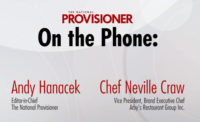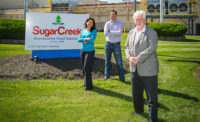Director of Sales for SugarCreek Jennifer Hutcheson details the benefits of the sous vide process and describes how SugarCreek collaborated with Arby’s to reach their goals.
Andy Hanacek: Hello again viewers. Welcome to yet another phone interview with my friends at SugarCreek around sous vide and their partnership with Arby’s. Today I have Jennifer Hutcheson on the phone. Jennifer, thanks for joining me today. I hope you are weathering the brutal cold of winter that we are experiencing right now out there in Ohio.
Jennifer Hutcheson: Good morning Andy. We’re trying to, but it’s pretty frigid here today. We appreciate you talking to us.
Hanacek: Perfect. Let’s jump right in to sous vide. Let’s talk about the benefits of sous vide from SugarCreek’s perspective. What are you going out to the QSR, casual-restaurant industry and talking to them about regarding sous vide and the process that you guys can provide and have provided to some of the customers.
Hutcheson: From our point of view, we feel the benefits of sous vide not only for QSR but for the restaurant industry as a whole are great, and as we think specifically about the QSR world, there’s several different benefits that we tend to focus on when we first talk to a customer, and that is quality and consistency. There’s operational benefits. There are economic benefits. There are food safety benefits, and there are health benefits, so what this technology can really bring to the table, specifically to a QSR customer is several… the ability for them to put out proteins or whatever it might be consistently everyday precisely that really takes a lot of the variability out of what they might experience not using this technology. From an economic standpoint, there’s oftentimes less space. There’s opportunities to use more inexpensive cut of meat and able to retherm those in a way that really highlight what those proteins can show. Operationally, being able to streamline the back of the house [is a benefit]. From a food safety perspective, not handling raw protein and then going to touch something else. From a health perspective, just having clean labels, and being able to start with a protein or an item that is fully cooked and being able to reconstitute that in whatever way is appropriate is really a huge benefit. The conversation is one in which we can provide several different benefits using this technology.
Hanacek: SugarCreek has developed this type of a partnership with Arby’s. Using Arby’s as an example, talk about what SugarCreek is trying to develop in that partnership. How does it work? It’s a partnership, so I’m sure there is a lot of mutual work that goes on, but is it typically SugarCreek saying ‘hey, Arby’s, we have this sous vide process. You should try us for certain products that you have’? Or is an Arby’s-type customer come and say ‘we want to do this. Can you do it, and can we do sous vide?’
Hutcheson: It’s a little bit of both, but to take Arby’s specifically, they have been an absolutely tremendous partner. We are building a long-lasting relationship. They have really been quite something to work with. As it relates to the sous vide technology, it’s co-collaboration. It is really us as SugarCreek working with their team to help them with reaching their needs. What is their end goal. What are they trying to achieve with any one particular protein? And working together in various ideations and tweaking things and trying to… really our goal for them is to get them to a place where they are happy with the end result. So it’s both, and not even on the sous vide side. As we think about all of our technologies as a company, we are able to provide a customer like Arby’s with not just this particular technology, but how can we combine the other technologies that we have as a company to really create the ultimate end goal. There is a lot of co-collaboration, a lot of co-innovation that goes on, and really that’s our approach and will be our approach with other customers as well. How can we as SugarCreek help our customers achieve their goals in the next two to three years.
Hanacek: That’s perfect. I was going to say it goes beyond sous vide as well, I’m sure, because you guys have so many capabilities in your plants. So that makes a lot of sense. Thanks for getting into that as well. I know we have been talking about sous vide, sous vide, sous vide. What does the future hold for sous vide in the marketplace from your perspective? Do you personally believe this is the kind of technology that consumers will ask restaurants and retailers to adopt for their products or are consumers just going to be happy to get the consistency and maybe not worry as much about how the product was processed at a plant like SugarCreek?
Hutcheson: We absolutely feel that this technology has got some fantastic benefits, not only in the restaurant industry, but for sure an end-user home use. Just the benefits that we spoke about earlier, those don’t just apply to the back of the house at a QSR chain. Those absolutely are important benefits to someone in a household. Really what the technology also provides, it allows the end-user multiple ways in which to reheat the protein or whatever it is they might be using. You’re starting out with a ready-to-eat product, but you are able to as a home user put your stamp on it. You can grill it, you can sear it, you can do whatever it is to that particular item to meet your needs. We do feel very strongly and are very excited that consumers in the industry start to learn more about this technology, it will become more and more used in the future. We’re very excited about the opportunity ahead and are really looking forward to reaching that consumer in a new and innovative way.



Report Abusive Comment